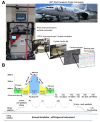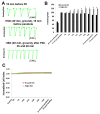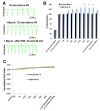Parabolic, Flight-Induced, Acute Hypergravity and Microgravity Effects on the Beating Rate of Human Cardiomyocytes
- PMID: 31013958
- PMCID: PMC6523861
- DOI: 10.3390/cells8040352
Parabolic, Flight-Induced, Acute Hypergravity and Microgravity Effects on the Beating Rate of Human Cardiomyocytes
Abstract
Functional studies of human induced pluripotent stem cell (hiPSC)-derived cardiomyocytes (hCMs) under different gravity conditions contribute to aerospace medical research. To study the effects of altered gravity on hCMs, we exposed them to acute hypergravity and microgravity phases in the presence and absence of the β-adrenoceptor isoprenalin (ISO), L-type Ca2+ channel (LTCC) agonist Bay-K8644, or LTCC blocker nifedipine, and monitored their beating rate (BR). These logistically demanding experiments were executed during the 66th Parabolic Flight Campaign of the European Space Agency. The hCM cultures were exposed to 31 alternating hypergravity, microgravity, and hypergravity phases, each lasting 20-22 s. During the parabolic flight experiment, BR and cell viability were monitored using the xCELLigence real-time cell analyzer Cardio Instrument®. Corresponding experiments were performed on the ground (1 g), using an identical set-up. Our results showed that BR continuously increased during the parabolic flight, reaching a 40% maximal increase after 15 parabolas, compared with the pre-parabolic (1 g) phase. However, in the presence of the LTCC blocker nifedipine, no change in BR was observed, even after 31 parabolas. We surmise that the parabola-mediated increase in BR was induced by the LTCC blocker. Moreover, the increase in BR induced by ISO and Bay-K8644 during the pre-parabola phase was further elevated by 20% after 25 parabolas. This additional effect reflects the positive impact of the parabolas in the absence of both agonists. Our study suggests that acute alterations of gravity significantly increase the BR of hCMs via the LTCC.
Keywords: Bay-K8644; Isoprenaline; L-type Ca2+ channels; adrenoceptor agonist; cardiomyocytes; human induced pluripotent stem cells; hypergravity; microgravity.
Conflict of interest statement
All authors have contributed substantially to this work and declare no conflicts of interest. The authors have no ethical conflicts to disclose.
Figures




References
Publication types
MeSH terms
Substances
LinkOut - more resources
Full Text Sources
Molecular Biology Databases
Miscellaneous

